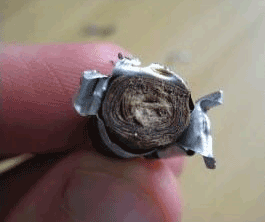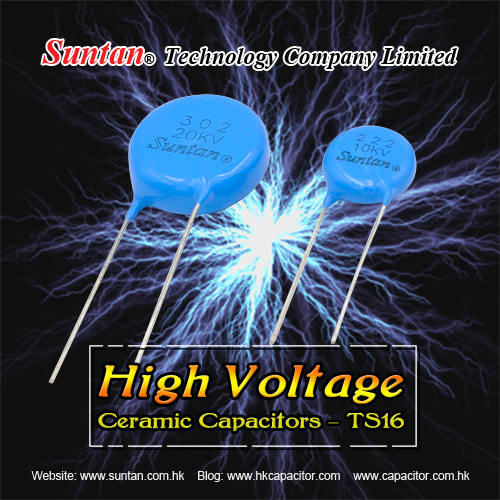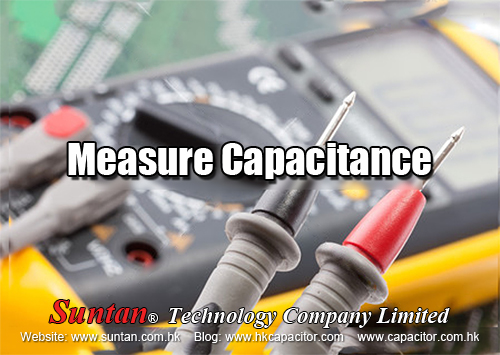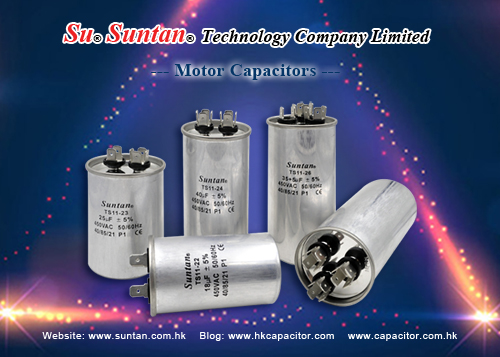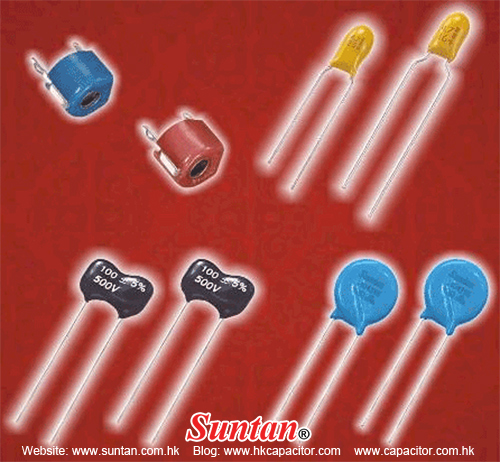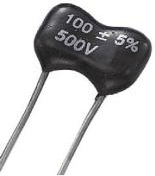Suntan Technology Company Limited
----All Kinds of Capacitors
When reading schematics, repairing radios and buying capacitors, you often must convert between uF, nF and pF.
Paper and electrolytic capacitors are usually expressed in terms of uF (microfarads). Short forms for micro farad include uF, mfd, MFD, MF and UF. Mica capacitors are usually expressed in terms of pF (micromicrofarads) (picofarads).
Short forms for micromicrofarads include pF, mmfd, MMFD, MMF, uuF and PF. A pF is one-millionth of a uF. In between a pF and a uF is a nF which is one-one thousands of a uF. Converting back and forth between uF, nF and pF can be confusing with all those darn decimal points to worry about. Below is a uF - nF- pF conversion chart.
| uF/ MFD | nF | pF/ MMFD |
| 1uF / MFD | 1000nF | 1000000pF |
| 0.82uF / MFD | 820nF | 820000pF |
| 0.8uF / MFD | 800nF | 800000pF |
| 0.7uF / MFD | 700nF | 700000pF |
| 0.68uF / MFD | 680nF | 680000pF |
| 0.6uF / MFD | 600nF | 600000pF |
| 0.56uF / MFD | 560nF | 560000pF |
| 0.5uF / MFD | 500nF | 500000pF |
| 0.47uF / MFD | 470nF | 470000pF |
| 0.4uF / MFD | 400nF | 400000pF |
| 0.39uF / MFD | 390nF | 390000pF |
| 0.33uF / MFD | 330nF | 330000pF |
| 0.3uF / MFD | 300nF | 300000pF |
| 0.27uF / MFD | 270nF | 270000pF |
| 0.25uF / MFD | 250nF | 250000pF |
| 0.22uF / MFD | 220nF | 220000pF |
| 0.2uF / MFD | 200nF | 200000pF |
| 0.18uF / MFD | 180nF | 180000pF |
| 0.15uF / MFD | 150nF | 150000pF |
| 0.12uF / MFD | 120nF | 120000pF |
| 0.1uF / MFD | 100nF | 100000pF |
| 0.082uF / MFD | 82nF | 82000pF |
| 0.08uF / MFD | 80nF | 80000pF |
| 0.07uF / MFD | 70nF | 70000pF |
| 0.068uF / MFD | 68nF | 68000pF |
| 0.06uF / MFD | 60nF | 60000pF |
| 0.056uF / MFD | 56nF | 56000pF |
| 0.05uF / MFD | 50nF | 50000pF |
| 0.047uF / MFD | 47nF | 47000pF |
| 0.04uF / MFD | 40nF | 40000pF |
| 0.039uF / MFD | 39nF | 39000pF |
| 0.033uF / MFD | 33nF | 33000pF |
| 0.03uF / MFD | 30nF | 30000pF |
| 0.027uF / MFD | 27nF | 27000pF |
| 0.025uF / MFD | 25nF | 25000pF |
| 0.022uF / MFD | 22nF | 22000pF |
| 0.02uF / MFD | 20nF | 20000pF |
| 0.018uF / MFD | 18nF | 18000pF |
| 0.015uF / MFD | 15nF | 15000pF |
| 0.012uF / MFD | 12nF | 12000pF |
| 0.01uF / MFD | 10nF | 10000pF |
| 0.0082uF / MFD | 8.2nF | 8200pF |
| 0.008uF / MFD | 8nF | 8000pF |
| 0.007uF / MFD | 7nF | 7000pF |
| 0.0068uF / MFD | 6.8nF | 6800pF |
| 0.006uF / MFD | 6nF | 6000pF |
| 0.0056uF / MFD | 5.6nF | 5600pF |
| 0.005uF / MFD | 5nF | 5000pF |
| 0.0047uF / MFD | 4.7nF | 4700pF |
| 0.004uF / MFD | 4nF | 4000pF |
| 0.0039uF / MFD | 3.9nF | 3900pF |
| 0.0033uF / MFD | 3.3nF | 3300pF |
| 0.003uF / MFD | 3nF | 3000pF |
| 0.0027uF / MFD | 2.7nF | 2700pF |
| 0.0025uF / MFD | 2.5nF | 2500pF |
| 0.0022uF / MFD | 2.2nF | 2200pF |
| 0.002uF / MFD | 2nF | 2000pF |
| 0.0018uF / MFD | 1.8nF | 1800pF |
| 0.0015uF / MFD | 1.5nF | 1500pF |
| 0.0012uF / MFD | 1.2nF | 1200pF |
| 0.001uF / MFD | 1nF | 1000pF |
| 0.00082uF / MFD | 0.82nF | 820pF |
| 0.0008uF / MFD | 0.8nF | 800pF |
| 0.0007uF / MFD | 0.7nF | 700pF |
| 0.00068uF / MFD | 0.68nF | 680pF |
| 0.0006uF / MFD | 0.6nF | 600pF |
| 0.00056uF / MFD | 0.56nF | 560pF |
| 0.0005uF / MFD | 0.5nF | 500pF |
| 0.00047uF / MFD | 0.47nF | 470pF |
| 0.0004uF / MFD | 0.4nF | 400pF |
| 0.00039uF / MFD | 0.39nF | 390pF |
| 0.00033uF / MFD | 0.33nF | 330pF |
| 0.0003uF / MFD | 0.3nF | 300pF |
| 0.00027uF / MFD | 0.27nF | 270pF |
| 0.00025uF / MFD | 0.25nF | 250pF |
| 0.00022uF / MFD | 0.22nF | 220pF |
| 0.0002uF / MFD | 0.2nF | 200pF |
| 0.00018uF / MFD | 0.18nF | 180pF |
| 0.00015uF / MFD | 0.15nF | 150pF |
| 0.00012uF / MFD | 0.12nF | 120pF |
| 0.0001uF / MFD | 0.1nF | 100pF |
| 0.000082uF / MFD | 0.082nF | 82pF |
| 0.00008uF / MFD | 0.08nF | 80pF |
| 0.00007uF / MFD | 0.07nF | 70pF |
| 0.000068uF / MFD | 0.068nF | 68pF |
| 0.00006uF / MFD | 0.06nF | 60pF |
| 0.000056uF / MFD | 0.056nF | 56pF |
| 0.00005uF / MFD | 0.05nF | 50pF |
| 0.000047uF / MFD | 0.047nF | 47pF |
| 0.00004uF / MFD | 0.04nF | 40pF |
| 0.000039uF / MFD | 0.039nF | 39pF |
| 0.000033uF / MFD | 0.033nF | 33pF |
| 0.00003uF / MFD | 0.03nF | 30pF |
| 0.000027uF / MFD | 0.027nF | 27pF |
| 0.000025uF / MFD | 0.025nF | 25pF |
| 0.000022uF / MFD | 0.022nF | 22pF |
| 0.00002uF / MFD | 0.02nF | 20pF |
| 0.000018uF / MFD | 0.02nF | 20pF |
| 0.000015uF / MFD | 0.015nF | 15pF |
| 0.000012uF / MFD | 0.012nF | 12pF |
| 0.00001uF / MFD | 0.01nF | 10pF |
| 0.0000082uF / MFD | 0.0082nF | 8.2pF |
| 0.000008uF / MFD | 0.008nF | 8pF |
| 0.000007uF / MFD | 0.007nF | 7pF |
| 0.0000068uF / MFD | 0.0068nF | 6.8pF |
| 0.000006uF / MFD | 0.006nF | 6pF |
| 0.0000056uF / MFD | 0.0056nF | 5.6pF |
| 0.000005uF / MFD | 0.005nF | 5pF |
| 0.0000047uF / MFD | 0.0047nF | 4.7pF |
| 0.000004uF / MFD | 0.004nF | 4pF |
| 0.0000039uF / MFD | 0.0039nF | 3.9pF |
| 0.0000033uF / MFD | 0.0033nF | 3.3pF |
| 0.000003uF / MFD | 0.003nF | 3pF |
| 0.0000027uF / MFD | 0.0027nF | 2.7pF |
| 0.0000025uF / MFD | 0.0025nF | 2.5pF |
| 0.0000022uF / MFD | 0.0022nF | 2.2pF |
| 0.000002uF / MFD | 0.002nF | 2pF |
| 0.0000018uF / MFD | 0.0018nF | 1.8pF |
| 0.0000015uF / MFD | 0.0015nF | 1.5pF |
| 0.0000012uF / MFD | 0.0012nF | 1.2pF |
| 0.000001uF / MFD | 0.001nF | 1pF |
+/-5%(J), +/-10%(K), +/-20%(M)The letter after the marking often indicates the tolerance.
Example:101K would be 100pf, +/-10%
When You Are Tired, Do You Get a Headache Converting Picofarads to Microfarads?
Maybe this will help you.
| 4.7 mmf or pf | = | .0000047 mf |
| 47 mmf or pf | = | .000047 mf |
| 470 mmf or pf | = | .00047 mf |
| 4,700 mmf or pf | = | .0047 mf |
| 47,000 mmf or pf | = | .047 mf |
| 470,000 mmf or pf | = | .47 mf |

